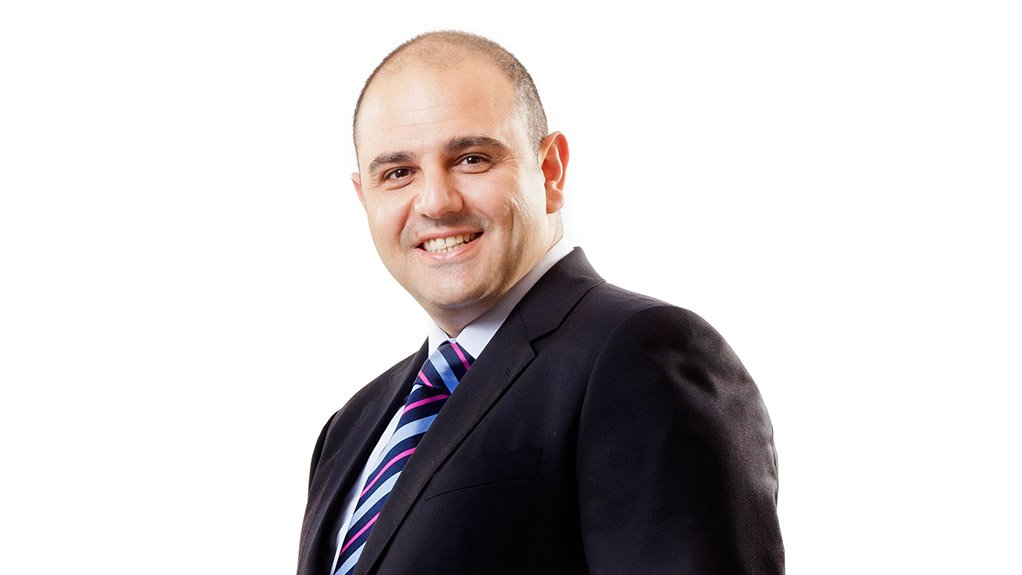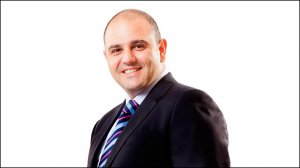Tharisa records maiden FY profit, targets further cost efficiencies


Tharisa CEO Phoevos Pouroulis discusses the company’s results. Video and editing: Nicholas Boyd
Tharisa CEO Phoevos Pouroulis
JOHANNESBURG (miningweekly.com) – JSE-listed integrated resource group Tharisa on Wednesday reported its first full-year profit of $6-million for the financial year to September 30.
This compared with a loss of $54.9-million in the prior financial year.
Group revenue increased by 2.5% year-on-year to $246.8-million in the year under review.
The platinum group metals (PGMs) and chromium concentrates producer said the higher revenue was mainly owing to the 49.1% year-on-year increase in PGM sales, and in spite of the 19.8% in the PGM basket price from an average of $1 103/oz in the 2014 financial year to an average of $885/oz for the year under review.
Tharisa CEO Phoevos Pouroulis said the company’s mining operations were characterised by the shallow openpit, large-scale coproduction of PGMs and chrome concentrates with a consequential low cost of production.
He noted that the continuing application of Tharisa’s low-cost business model in the face of declining concentrate prices had enabled the company to boost gross profit by 32.2% year-on-year to $43.1-million.
“Our full-year results show a business in the final stages of ramp-up and yet to reach maturity. The posted profit is encouraging and bodes well for our plans to reach steady-state in the year ahead,” said Pouroulis.
He commented that Tharisa had “clearly benefited” from its low-cost model over the past year and that it had boosted its cost performance through a variety of efficiency initiatives.
However, Pouroulis noted that the recent further decline of the PGM basket price and cost, insurance and freight metallurgical chrome concentrate prices reinforced the need for the business to become “even more cost effective”.
He highlighted that the company would launch additional cost saving initiatives in light of the current state of spot markets. This would include reducing overhead and operational costs by up to 10% and improving efficiencies in mining by reducing dilution to provide stable feed into the processing plants.
“These activities will, ultimately, improve the recovery of PGMs and chrome concentrate, while reducing our cost base,” Pouroulis asserted.
THARISA MINE
Pouroulis noted that there was an “underperformance” of reef mining at the company’s Tharisa chromite and PGMs mine near Marikana, in North West, as targets were not being met.
He explained that this had led to a strategic review of the mine’s multicontractor mining model. Pouroulis said a decision was taken after the year-end to revert to a single mining contractor and the transition had since been implemented according to plan.
He stated that the mine’s processing plants performed well when they were fed with consistent run-of-mine production in spite of lower-than-anticipated feed grades.
“The overall performance across both plants saw a marked improvement in PGM recoveries at 65.8% for the financial year and a slight decrease in chrome recoveries of 1.4% year-on-year.
“This decrease can mainly be attributable to lower and unstable chrome feed grades into the chrome plants and the reprocessing of commissioning tails,” Pouroulis said.
PGM concentrate production continued to be sold to Impala Refining Services in terms of the offtake agreement, with a total of 119.9 oz of contained PGMs being sold during the year, which equated to a 49.1% year-on-year sales increase.
Additionally, the mine’s chrome concentrate sales totalled 1.1-million tons, 136.1 t of which was higher value-add chemical and foundry grade chrome concentrates with the bulk of the production being metallurgical grade chrome concentrate.
“China remains the main market for metallurgical chrome concentrates. The chrome segment gross margin of 14.6% was significantly higher than the year before with contributing factors including competitively priced freight costs for bulk shipments of chrome concentrates,” highlighted Pouroulis.
OUTLOOK
Pouroulis stated that the general mining environment was under “immense pressure”. He said that, coupled with domestic challenges, this meant that Tharisa’s business model was being stress tested.
“We are confident that we will succeed and emerge leaner, more efficient and ready to reap the rewards of an improving global commodity market. Our plans to reach steady-state remain a priority and we have made positive strides towards achieving the recoveries required to attain those production levels,” he contended.
Pouroulis enthused that Tharisa’s financial performance proved that it could remain profitable and continue operations based on its original plan and trajectory as set out during the first half of 2015.
“With the stringent management of our costs and improved efficiencies, we continue to be firmly positioned in the lowest-cost quartile for both PGM and chrome concentrate producers.
“Our continued commitment to a zero harm workplace has been reinforced with the inspectorate of the Department of Mineral Resources and we are pleased to advise that, through constructive engagement, we are aligned with the Mine Health and Safety Act and welcome the positive changes post the recorded Section 54 stoppages during the past year,” he said.
Commenting on Tharisa’s results, independent investment dealer GMP Securities said: “Frankly, in the current commodity price environment in South Africa, this is a leading performance against peers variably shutting down assets and undertaking emergency distressed fundraisings.”
The company added that Tharisa’s relative outperformance was “once again very simply related to the company’s in-production status” and lowest-quartile costs for both PGMs and chrome.
However, GMP noted that the solid operating and financial performance was overshadowed by the deterioration of both chrome and PGM prices reported post period end, and pointed out that Tharisa had flagged that additional cash would be needed if depressed commodity prices persisted.
“Looking forward, we would say Tharisa is better placed than almost any South African peer, as its mines continue to make cash at an operating level,” GMP added.
Comments
Press Office
Announcements
What's On
Subscribe to improve your user experience...
Option 1 (equivalent of R125 a month):
Receive a weekly copy of Creamer Media's Engineering News & Mining Weekly magazine
(print copy for those in South Africa and e-magazine for those outside of South Africa)
Receive daily email newsletters
Access to full search results
Access archive of magazine back copies
Access to Projects in Progress
Access to ONE Research Report of your choice in PDF format
Option 2 (equivalent of R375 a month):
All benefits from Option 1
PLUS
Access to Creamer Media's Research Channel Africa for ALL Research Reports, in PDF format, on various industrial and mining sectors
including Electricity; Water; Energy Transition; Hydrogen; Roads, Rail and Ports; Coal; Gold; Platinum; Battery Metals; etc.
Already a subscriber?
Forgotten your password?
Receive weekly copy of Creamer Media's Engineering News & Mining Weekly magazine (print copy for those in South Africa and e-magazine for those outside of South Africa)
➕
Recieve daily email newsletters
➕
Access to full search results
➕
Access archive of magazine back copies
➕
Access to Projects in Progress
➕
Access to ONE Research Report of your choice in PDF format
RESEARCH CHANNEL AFRICA
R4500 (equivalent of R375 a month)
SUBSCRIBEAll benefits from Option 1
➕
Access to Creamer Media's Research Channel Africa for ALL Research Reports on various industrial and mining sectors, in PDF format, including on:
Electricity
➕
Water
➕
Energy Transition
➕
Hydrogen
➕
Roads, Rail and Ports
➕
Coal
➕
Gold
➕
Platinum
➕
Battery Metals
➕
etc.
Receive all benefits from Option 1 or Option 2 delivered to numerous people at your company
➕
Multiple User names and Passwords for simultaneous log-ins
➕
Intranet integration access to all in your organisation




















